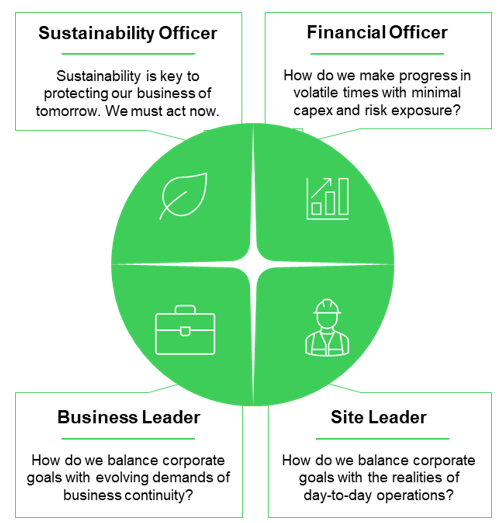The Road to Success: The Crucial Role of Governance in Sustainability Programs

In recent years, there has been a notable surge in global companies setting ambitious sustainability targets, with nearly 60% of industrial companies publicly declaring their goals. However, despite having clear roadmaps, only 10% of Fortune Global 500 companies are currently meeting their ESG targets1.
Many clients encounter difficulties transitioning from ambition to action due to organizational hurdles. We have identified four barriers to sustainability action: governance alignment, data transparency, financial enablement, and enterprise-wide execution.
This article focuses on: governance alignment. Check out these resources for insights on the other core barriers.
Why is governance so crucial?
Governance is the playbook by which the sustainability program plays. Enterprise and site-level alignment is vital to the success of a sustainability program, and therefore proper governance cannot be overlooked. Aligning corporate- and site-level stakeholders ensures that sustainability ambitions support operational performance goals. A business case for sustainability will only be successful if it aligns all stakeholders to drive impact.
According to a study by The Center for Sustainable Business at the University of Pittsburgh and The Harris Poll, 45% of respondents believe sustainability is someone else’s responsibility2. This finding highlights a critical need for more structured approaches to improve accountability and to drive the overall effectiveness of sustainability initiatives across an organization.
Governance alignment enables:
- Accountability: Governance structures establish clear roles, responsibilities, and accountability for decarbonization initiatives, ensuring that targets are met, and progress is monitored.
- Strategic Alignment: Effective governance ensures that decarbonization efforts are aligned with the organization's overall strategy and objectives, integrating sustainability into the core business model.
- Risk Management: Proper governance identifies and manages risks associated with decarbonization, including regulatory compliance, financial risks, and reputational risks.
- Resource Allocation: Governance ensures that the necessary resources, both financial and human, are allocated to support decarbonization programs effectively.
- Stakeholder Engagement: Strong governance involves engaging with stakeholders, including investors, customers, and employees, to support transparency and buy-in for decarbonization efforts.
- Continuous Improvement: Governance frameworks facilitate the measurement, reporting, and verification of decarbonization efforts, enabling continuous improvement and adaptation to new challenges and opportunities.
Governance in action: build a robust governance framework in four steps

When it comes to governance, Schneider Electric Sustainability Business is laser-focused on establishing alignment between corporate-and site-level stakeholders. We utilize a workshop approach where all needed stakeholders and decision-makers are in the same room to set goals and strategies.
- Align on shared strategic targets and KPIs
- Establish ROI criteria to enable decision making
- Engage all stakeholders needed to enable approvals
- Build consensus on measurement methodology to track KPI’s
Ultimately, the success of a sustainability business case hinges on its ability to address the needs of all stakeholders. This is precisely where our Governance Alignment strategy plays a pivotal role!
Consider this example from one of our clients: a global industrial manufacturer operating in over 18 countries with a centralized sustainability program and high ambitions. In this case, success of the sustainability program hinged on governance alignment in the following areas:
Vision: Align on how the sustainability strategy, vision and targets are created and communicated internally and externally & how employees connect to strategic drivers
Organization: Align on how human resources are organized across business groups and geographies and what committees are in place to develop and execute the program
Information: Align on the flow of information in the organization, across business groups and from shop floor to top floor. Define the frequency, content, channels and data sources
Financial Resources: Define what capital is available and align on project evaluations, prioritization processes, and financial enablement that translates the program vision into tangible results
Activities: Align on what individuals do throughout the program and how activities impact the results of the program.
In collaboration with the client’s corporate-and site-level stakeholders, we meticulously mapped out the solutions for each key area, gathering input from all facets of the business to ensure comprehensive success in addressing these challenges.
What’s next for you?
Contact us today to start making sustainability work for you by partnering with Schneider Electric.
Contributor:

For a deep dive into other obstacles within this series, check out our on-demand webinar with James Potach, Senior Vice President Sustainability Business.
Sources:
[1] https://www.climateimpact.com/news-insights/fortune-global-500-climate-commitments
[2] https://trellis.net/article/how-to-navigate-six-common-barriers-to-embedding-sustainability/